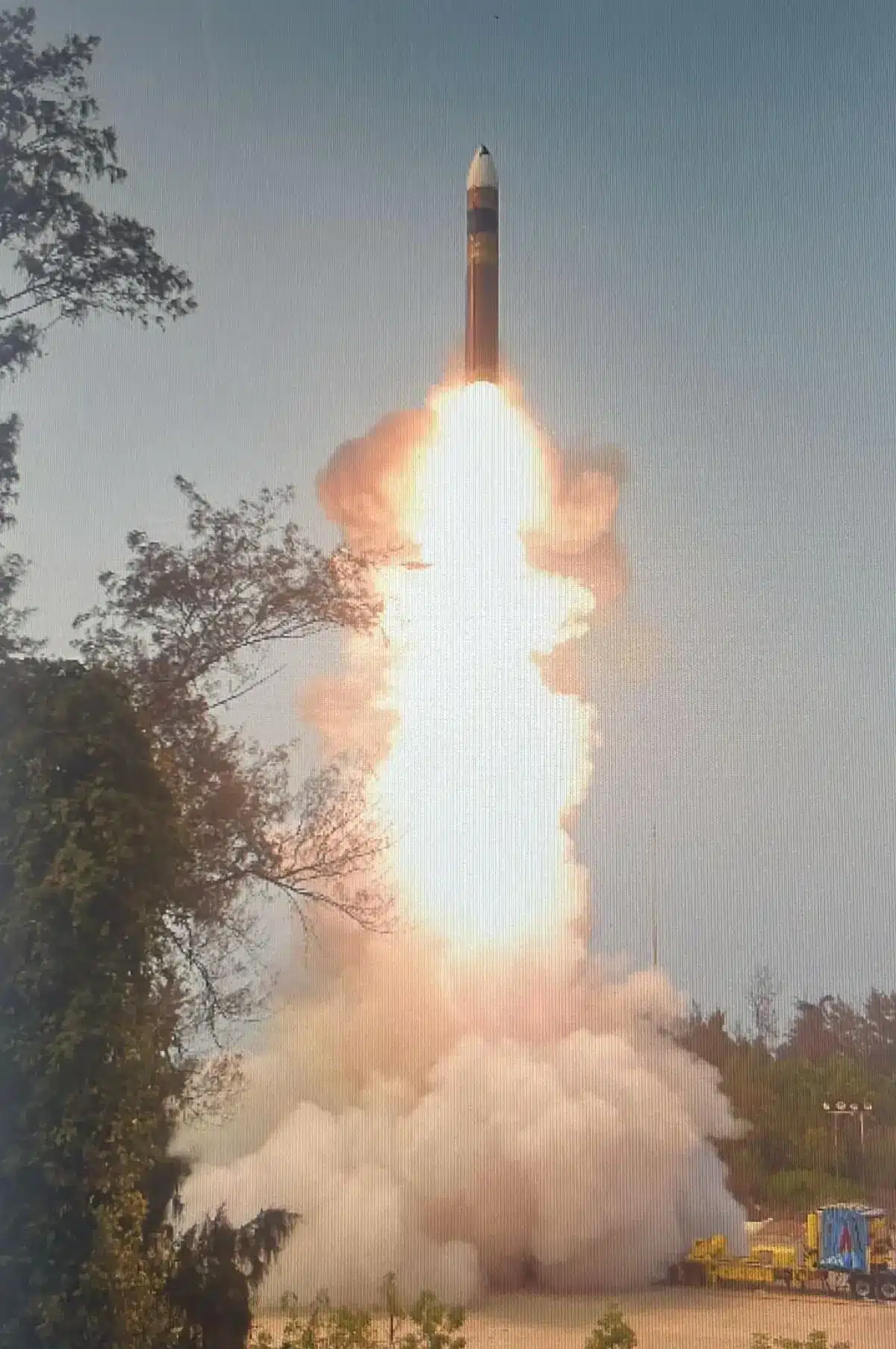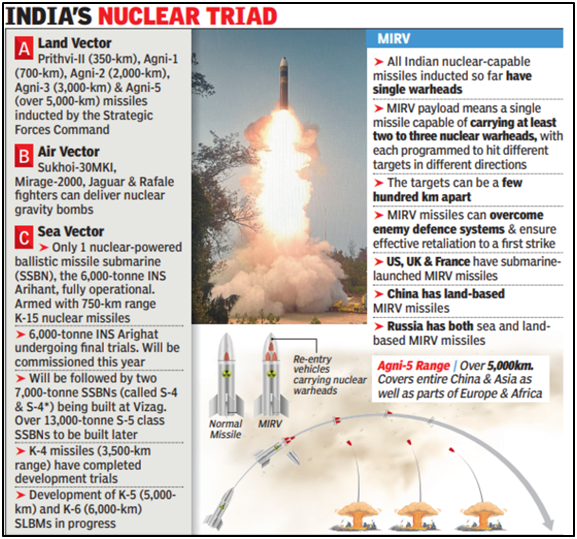What’s in Today’s Article?
- Why in the News?
- Brief History of India’s Missile Technology
- Post-Independence
- Integrated Guided Missiles Development Programme (IGMDP)
- Agni Ballistic Missile System
- List of Agni missiles with their range
- About BrahMos Missile
- Missile Systems & future technologies under various stages of development
- News Summary
- About Multiple Independently Targetable Re-entry Vehicle (MIRV) Technology
Why in the News?
On March 11, Prime Minister Modi announced the successful flight test of an Agni V ballistic missile with Multiple Independently targetable Re-entry Vehicle (MIRV) technology.
Brief History of India’s Missile Technology
- Before Independence, several kingdoms in India were using rockets as part of their warfare technologies.
- Mysore ruler Hyder Ali started inducting iron-cased rockets in his army in the mid-18th
- By the time Hyder’s son Tipu Sultan died, a company of rocketeers was attached to each brigade of his army, which has been estimated at around 5,000 rocket-carrying troops.
Post-Independence
- At the time of Independence, India did not have any indigenous missile capabilities. The Union Government created the Special Weapon Development Team in 1958.
- This was later expanded and became Defence Research and Development Laboratory (DRDL) in 1961.
- DRDL is now a part of the Defence Research and Development Organization (DRDO).
- In 1972, Project Devil, for the development of a medium range Surface-to-Surface Missile was initiated.
- The development of components / systems for Project Devil formed the technology base for the future Integrated Guided Missiles Development Programme.
Integrated Guided Missiles Development Programme (IGMDP)
- IGMDP was a Ministry of Defence programme for the research and development of the comprehensive range of missiles.
- The project started in 1982–83 under the leadership of Dr APJ Abdul Kalam who oversaw its ending in 2008 after these strategic missiles were successfully developed.
- Nodal agencies: DRDO and Ordnance Factories Board
- The 5 missiles developed under this program are:
- Prithvi: Short range surface to surface ballistic missile
- Trishul: Short range low level surface to air missile
- Nag: Anti-tank guided missile
- Akash: Medium range surface to air missile
- Agni: Surface to surface ballistic missiles with different ranges
Agni Ballistic Missile System
- The first missile of the series, Agni-I was developed under the IGMDP and tested in 1989.
- The Agni missile family consists of four deployed variants, i.e. Agni-I, Agni-II, Agni-III and Agni-IV are already in service with the Indian Army.
- Agni-V was successfully test-fired in December, 2018.
- All Agni missiles are nuclear-capable ballistic missile system.
List of Agni missiles with their range
- Agni-I: 700-800 Km
- Agni-II: 2000 Km
- Agni-III: 3000 Km
- Agni-IV: 4000 Km
- Agni-V: 5000 Km
- The Agni-V is an intercontinental range ballistic missile with three solid fuel stages.
About BrahMos Missile
- The BrahMos Missile is a supersonic cruise missile jointly developed by DRDO and Russia.
- It is named after the rivers Brahmaputra and Moskva.
- Brahmos is a multiplatform i.e., it can be launched from land, air, and sea.
- It became operational in 2006.
- Range: 300-500 Km
Missile Systems & future technologies under various stages of development
- Astra: Beyond Visual Range Air-to-Air Missile. It is under induction.
- Rudram: New Generation Anti-Radiation Missile. It has cleared initial tests.
- India is also testing Hypersonic technology.
- Hypersonic missiles travel at Mach 5, five times the speed of sound.
- Under Mission Shakti, India had successfully tested anti-satellite missile system in April, 2019.
- Only three other countries, United States, Russia and China, have anti-satellite capabilities in the world.
Mission Divyastra
- On March 11, Prime Minister Narendra Modi announced the successful flight test of an Agni V ballistic missile with Multiple Independently targetable Re-entry Vehicle (MIRV) technology.
- Under ‘Mission Divyastra’, DRDO test fired Agni V ballistic missile.
- At present, the US, UK, France, China, Russia and India are among the elite group that possesses the technology.
About Multiple Independently Targetable Re-entry Vehicle (MIRV) Technology
- The MIRV have revolutionized the concept of ballistic missile payloads by enabling a single missile to carry multiple warheads, each capable of targeting enemies at different locations.
- The technology was first introduced in the US with the successful test of the Minuteman III in 1968, which brought the technology into actual use in the 1970.
- The Soviet Union developed their own MIRV-enabled ICBM and SLBM technology by the end of the 1970s.
- The strategic shift started by MIRV has enabled many nations to greater target damage and reduce the effectiveness of enemy missile systems, altering the landscape of global nuclear deterrence.
- The warheads on MIRVs can be launched at different speeds and in different directions. Some MIRVed missiles can hit targets as far as 1,500 km apart.
- The technology requires a delicate combination of large missiles, small warheads, precise guidance, and a complex mechanism for releasing warheads sequentially during flight.
Q1) What is the difference between a cruise missile and a ballistic missile?
Strategic missiles are either of the cruise or ballistic type. Cruise missiles are jet-propelled at subsonic speeds throughout their flights, while ballistic missiles are rocket-powered only in the initial (boost) phase of flight, after which they follow an arcing trajectory to the target.
Q2) What is Mission Shakti?
On 27 March 2019, India tested an anti-satellite weapon during an operation code named Mission Shakti. The target of the test was a satellite present in a low Earth orbit, which was hit with a kinetic kill vehicle.
Last updated on June, 2025
→ UPSC Notification 2025 was released on 22nd January 2025.
→ UPSC Prelims Result 2025 is out now for the CSE held on 25 May 2025.
→ UPSC Prelims Question Paper 2025 and Unofficial Prelims Answer Key 2025 are available now.
→ UPSC Calendar 2026 is released on 15th May, 2025.
→ The UPSC Vacancy 2025 were released 1129, out of which 979 were for UPSC CSE and remaining 150 are for UPSC IFoS.
→ UPSC Mains 2025 will be conducted on 22nd August 2025.
→ UPSC Prelims 2026 will be conducted on 24th May, 2026 & UPSC Mains 2026 will be conducted on 21st August 2026.
→ The UPSC Selection Process is of 3 stages-Prelims, Mains and Interview.
→ UPSC Result 2024 is released with latest UPSC Marksheet 2024. Check Now!
→ UPSC Toppers List 2024 is released now. Shakti Dubey is UPSC AIR 1 2024 Topper.
→ Also check Best IAS Coaching in Delhi

























